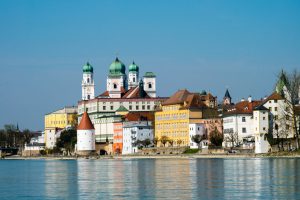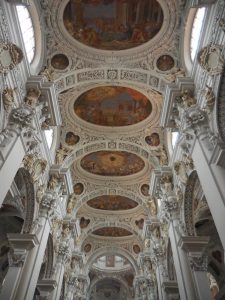Passau, Germany: A city rich in history, art and culture
By Tracy A. Burns
Passau in Germany
 Taking its name from one of the Roman forts that had been built in the region, Passau is situated at the confluence of three rivers – the Danube, the Inn, and the Ilz. The city offers a picturesque historical center with many sights – a cathedral, churches, museums, and an embankment perfect for a romantic stroll. For sport-oriented visitors, it is possible to make use of a cycling path going from Passau to Vienna. Many tourists on river cruises explore the city.
Taking its name from one of the Roman forts that had been built in the region, Passau is situated at the confluence of three rivers – the Danube, the Inn, and the Ilz. The city offers a picturesque historical center with many sights – a cathedral, churches, museums, and an embankment perfect for a romantic stroll. For sport-oriented visitors, it is possible to make use of a cycling path going from Passau to Vienna. Many tourists on river cruises explore the city.
History through the Renaissance
Passau’s Roman era hails from at least as far back as 2 BC when the Romans founded the town of Boiodurum in the region. During the fifth century, Saint Severinus established a monastery in the city. The diocese of Passau was founded in 739 and was the largest diocese in the Holy Roman Empire for a lengthy period. The area proved to be a major trade center specializing in salt deposits even in the Middle Ages as merchants made their way to Eastern Europe via the Danube. During the Renaissance, Passau was renowned for its sword-making.
The fire, World War II, and the floods
A fire destroyed most of the city in 1662 and after much reconstruction, a Baroque town emerged. During World War II Passau was the site of three sub-camps of the Mauthausen-Gusen concentration camp. After the war, the American sector set up a camp for displaced persons. Passau has been ravaged by floods throughout its history; the last major flood occurred as recently as 2013.
Significant personalities who have visited Passau
Throughout the centuries, Passau has been an important stop for many dignitaries. Emperor Leopold, I got married there while the then future Empress Elisabeth, often referred to as Sisi, resided here for six days en route to her wedding in Vienna.
Saint Stephen’s Cathedral
 The jewel of the city is Saint Stephen’s Cathedral, constructed in Italian Baroque style thanks to architect Carlo Lurago, who managed to preserve the Gothic features of the east choir. The cathedral is best known for having the largest organ outside of the United States. (Only one organ in Los Angeles is bigger.) The organ features 17,774 pipes and 233 registers. It took 17 years to decorate the cathedral and construct the side altars. The stucco adornment includes about 1,000 figures, such as prophets and cherubs. The central cupola features God the Father enthroned. The gilt pulpit hails from 1720.
The jewel of the city is Saint Stephen’s Cathedral, constructed in Italian Baroque style thanks to architect Carlo Lurago, who managed to preserve the Gothic features of the east choir. The cathedral is best known for having the largest organ outside of the United States. (Only one organ in Los Angeles is bigger.) The organ features 17,774 pipes and 233 registers. It took 17 years to decorate the cathedral and construct the side altars. The stucco adornment includes about 1,000 figures, such as prophets and cherubs. The central cupola features God the Father enthroned. The gilt pulpit hails from 1720.
The Glass Museum
However you decide to spend your time in Passau, do not miss a visit to the Passau Glass Museum, which houses the largest collection of Bohemian glass in the world. More than 15,000 objects from 1700 to 1950 are displayed on four floors. Tourists have the chance to see glassware of various styles, such as Baroque, Rococo, Empire, Biedermeier, Art Nouveau, and Art Deco. Whether or not you have a specific interest in glass, you will not be disappointed.
Veste Oberhaus
The fortress Veste Oberhaus looms over the city. When Bishop Ulrich became the first prince-bishop of the town in 1217, he founded a castle on the site. While the stronghold served as a military prison during the 19th and early 20th centuries, it now houses the largest city museum in lower Bavaria. The museum focuses on Passau’s history from its salt-trading days and also shows off Gothic and Baroque art plus porcelain. A firefighting museum and a restaurant are also on the premises. The citadel offers stunning views of the city. Notice how the three rivers are different colors – there is the dark Ilz, the blue Danube, and the light green Inn.
The town hall
The façade and interior of the Neo-Gothic town hall, built from 1889 to 1892, are stunning. Notice the water marks from floods past on the wall – the Great Flood was in 1501. The Rauthausturm tower of the town hall features a carillon that is the largest in Bavaria.
Niedernburg Abbey
Niedernburg Abbey was founded in 740 and housed Benedictine nuns as early as 1000 AD. In the Romanesque Holy Cross Church, check out the numerous Hungarian wreaths on former abbess Queen Gisela’s coffin. The wife of King Stephen of Hungary took refuge in the convent in 1046, after the death of her husband.
The Neue Residence
The Baroque Neue Residence, built from 1712 to 1730, boasts exquisite stucco ornamentation and a stunning ceiling painting of the gods of Olympus. The ornate stairway is one of the most beautiful in Germany. The palace is home to the Cathedral and Diocese Museum.
Two museums in the city
The Roman Museum is located on the site of one of the former Roman forts. It includes displays of items from the Stone Age, the Roman era, and the Middle Ages. Earthenware, weapons, ceramics, jewelry, bronze statuettes, and tombstones are on display, for example. The Museum of Modern Art is the only exhibition hall for modern art in Lower Bavaria and definitely worth a visit.
The Pilgrimage Church of Mariahilf
There are more sights outside of the city center. Three hundred and twenty-one steps will take you to the Pilgrimage Church of Mariahilf, established in the 17th century. It is where Emperor Leopold I prayed there for a victory over the Turks, and his prayer was answered. The Madonna on the Baroque main altar is a copy of a rendering by Lucas Cranach the Elder.
A superb day trip from Prague
Passau offers a variety of sights, whether your interest is in the Roman era, modern art, or glassware. Your trip to Passau is not complete with a visit to its splendid Baroque cathedral, and there are churches as well that are sure to impress. Take a walk along the embankment and down the picturesque side streets, and savor the delicious food in one of the delightful cafes or restaurants. A mere four hours from Prague, Passau is a superb choice for a day trip from the Czech capital.




